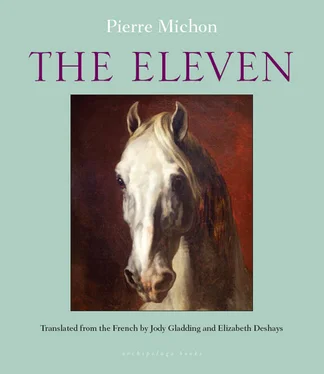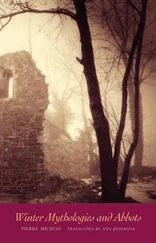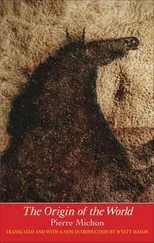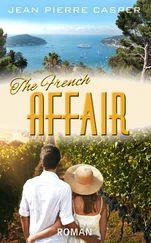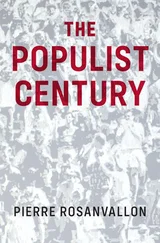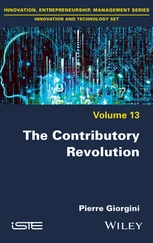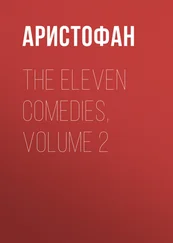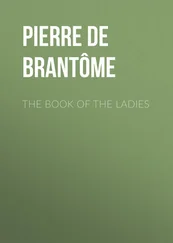It is a great pleasure to take up residence in numbers.
BAUDELAIRE
He was not tall, unobtrusive, but he held your attention with his feverish silence, his dark cheer, his alternately arrogant and oblique manner — grim, as they said. At least that was how he was seen later in life. None of that appears on the Würzburg ceilings, on the south wall of the Kaisersaal to be precise, in the wedding procession of Frederick Barbarossa, in the portrait Tiepolo left of him, when the model was twenty years old: he is there, so they say, and you can go see him, perched among a hundred princes, a hundred constables and ushers, as many slaves and merchants, porters, putti and animals, gods, merchandise, clouds, the four seasons and the four continents, and two incontestable painters, the ones who assembled the world that way in its exhaustive recension and are nevertheless of the world, Giambattista Tiepolo himself and Giandomenico Tiepolo, his son. So he is there as well, tradition has it that he is there, and that he is the page who bears the crown of the Holy Empire on a gold-tasseled cushion; you can see his hand under the cushion, his slightly tilted face is looking down toward the ground; his whole bent torso seems to accompany the weight of the crown: tenderly, suavely he gives way under the Empire.
He is fair.
This identification is most appealing, even if it is only a fantasy: this page is a type, not a portrait. Tiepolo took him from Veronese, not from among his young assistants; it is a page, it is the page, it is no one. Almost as dubious a legend has him appearing forty years later, perched high again in the tall windows visited by the wind, among the witnesses of the Tennis Court Oath in the sketch done of it by David: he is that ageless, hatted, oblique figure who is showing small children the surging fervor of five hundred sixty raised arms. Before this feverish but calm man, whose face does indeed resemble his, I side more with those who utter the name of Marat. Marat, yes — because that Rous-seauesque anecdote, those small children, that pedagogical farce, no, none of that is our man: although he did paint them, because they are objects of this world, he had no children and it is likely that he did not notice them, unless they, too, were his rivals in some way. And I am leaving out, regretfully, the graphite drawing by Georges Gabriel that was long taken for his portrait, where he appears in a hat again, face bulging, fearful, offended, as if caught with his hand in the bag, and which reminds me of a famous engraved self-portrait by Rembrandt; we now know that this is either the cobbler Simon, executioner and buffoon for the young Louis XVII at the Temple, or Léonard Bourdon, a frantic Sans Culotte from year II who switched camps during Thermidor. The handsome indubitable portrait that Vincent did of him after 1760, so in his mature years, and which belonged to Égalité, erstwhile Orléans, was lost during the Terror. There is no known self-portrait. Between the Holy Empire’s page and the raging oblique old man, we possess nothing that resembles him.
A late portrait of him attributed to Vivant Denon is a fake.
And that is all for appearance — for the posterity of appearance. It is little, and it is enough: a young man full of light that old age breaks and debases, a tender face crazed over time to the point that it can be confused with Simon’s, one of the most vile beings of those eras rich in monsters. That is him, that extraordinary aging. And to better enjoy Time’s farce, or to forget it for a moment, we like to recognize him in the young blond Würzburg boy. In that form we happily establish him in our dreams. He was handsome and insolent, loved, hated, he was one of those ambitious young men who have nothing to lose, who risk all, so enamored of the future that they seem to mirror the future of anyone who encounters them: and the men without futures detest him, and the others, no. A thousand novels were written about him, about the men amazed by him, about the women’s taste for him and his taste for them; we know the story of his skirmish with the prince-bishop over a girl, the chase in the great staircase, Tiepolo’s laughter above; we can almost hear that supernatural laugh of the magician; we begin to think it is all for him, the blond boy, all these haughty, easy women thrown onto the ceilings: so much so that in the fresco where the page appears, or legend has him appear, we sometimes have the impression (we want to have the impression) that ten steps in front of him the beautiful Beatrice of Burgundy kneeling beside her master the handsome Barbarossa directly below the cross, the miter, the glove of the prince-bishop who is marrying them, that Beatrice will next turn to him, rise, and with all her fair flesh and blue brocade walk toward him and, overturning the crown, embrace him.
I have that desire, that idea.
I might have many others, on the steps of that monumental stairway deep in the Franconian woods, with its magician on the scaffolding, the magician’s son who is learning the magic, and everywhere his young assistants who are running, laughing, whispering, murmuring, mixing the blue, the pink, the gold, climbing ladders, all spirits of the air. And what ideas I might have, too, with those pale wines they were drinking there. Because of course to evoke him, the boy, nothing would be sweeter to me than his first youth, in the Venice of the 1750s that dreams, dances, and dies, and above all in this aery, sylvan Franconia, peopled with fussy princelings and beautiful blonds, this Germanic land of plenty where Tiepolo in his great Mozartian cloak brought him from Venice. But time is pressing me to rejoin the other, the grim, ageless man who resembles the cobbler Simon — so I will not listen to those Germanic sirens; nor the others, the more tuneful, higher, Venetian ones, the siren Venice herself who in 1750 was like that beautiful young girl our grandmothers spoke of, whom they all had known, who was here below like an apparition of new, insatiable joy, who had danced all night, who danced on, and who in the morning, having drunk in one draft a tall glass of cold water, had fallen dead. No, no Venice, no young women, no romance; because all that, youth, fairness, wine of magic, Mozartian cloak, Giambattista Tiepolo the father with his four continents under the cloak, all those moving, living forms mean nothing more than this, tossed out to end up in a painting that repudiates them, exalts them, bludgeons them, weeps for that devastation and inordinately delights in it, eleven times, through eleven stations of the flesh, eleven stations of wool, silk, felt, eleven forms of men; all that makes sense and is spelled out clearly only in the page of darkness, The Eleven .
Since you ask, Sir, let us linger a moment longer on the great staircase. Let us visit this massive heap of marble that seems to fly in the air. Let us visit like the innocents we are. Let us look up. It was all commissioned, an extravagance of Karl Philipp von Greiffenclau, midget autocrat and megalomaniac of the Germanian heartland, a man of culture and follies, and of wisdom in his fashion; because it seems that despite the extravaganzas on the ceilings, with the few coins left him, Karl Philipp was gentle with his people, his serfs — his children, as they were called. And so, the great staircase. It was Neumann who made it, Balthasar Neumann: it is of the legendary stone, which all comes from Carrara, and the idea of Neumann’s or of someone else for the statues that rise from the banisters every three steps, that comes from Italy as well. The complete mythology of Italy looks down on you every three steps. It is wide as a boulevard rising toward this sky that Tiepolo paints but that he did not invent: the plan, the mental canvas for it, had been whispered into his ear by two Jesuit scholars, two Germans from Rome.
Читать дальше
